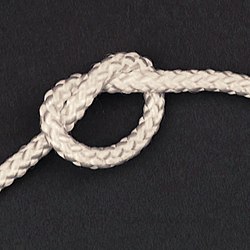Difference between revisions of "AY Honors/Braiding - Advanced"
(Created page with "<languages /> <tabs> <translate> <!--T:9--> {{honor_tab |honorname=Braiding - Advanced |skill=2 |year=1976 |category=Arts and Crafts |authority=General Conference |insignia=Br...") |
Jomegat bot (talk | contribs) m (Fix Tab Name transclusion) |
||
| Line 7: | Line 7: | ||
|skill=2 | |skill=2 | ||
|year=1976 | |year=1976 | ||
| − | |category=Arts and | + | |category=Arts, Crafts and Hobbies |
|authority=General Conference | |authority=General Conference | ||
|insignia=Braiding_Advanced.png | |insignia=Braiding_Advanced.png | ||
Revision as of 15:54, 16 January 2021
Overview
Take your braiding skills to the next level. What can you do with six or eight strands? Find out!
The Challenging Part
The most challenging requirement of this honor is probably this:
3. Make a six- or eight-strand zipper pull or key chain showing zigzag technique by reversing direction of braid, or make a project showing the three-part inside or trick braid.
1. Have the Braiding honor.
2. Make a six- or eight-strand zipper pull or key chain.
3. Make a six- or eight-strand zipper pull or key chain showing zigzag technique by reversing direction of braid, or make a project showing the three-part inside or trick braid.
4. Do one of the following:
- a. Six-strand lanyard
- b. Bookmark using at least six strands
- c. Four-strand dog leash using twine or wire for a core to braid around
5. Know how to start and end all projects.
| Printable Answer Key | Edit Answer Key |
1
For tips and instruction see Braiding.
2
Start with a keyring to anchor your strands to. Here are some resources explaining eight strand braiding:
3
There are a wide variety of interesting braids out there:
- Double Cobra Weave Variation created to put a lot of paracord into a short bracelet for use in a survival and climbing situations.
- 3 part inside or trick braid
4
4a
Good for holding a whistle, maybe snapped to your pack. Good resources:
4b
4c
5
How to start or end depends on the material being braided.
Starting
- Rope, string, or lace
- Lay the ropes (or strings or laces) parallel to one another with the ends even and tie an overhand knot in the entire bundle.
| Tying the Overhand Knot |
|---|
|
Use: one of the most fundamental knots and forms the basis of many others including the simple noose, overhand loop, angler's loop, reef knot, fisherman's knot and water knot. The overhand knot is very secure, and can jam badly, so only use if you want a permanent knot. It is often used to prevent the end of a rope or string from unraveling.
|
- Hair
- Bind the hair you wish to braid using an elastic band near the head. Divide into the desired number of equal-diameter strands.
- Leather
- A wide leather strap can be cut into strips, but left intact near one end.
Ending
- Rope, string, or lace
- Tie the bundle into an overhand knot.
- Hair
- Bind the braid with a rubber band or a decorative hair elastic.
- Leather
- Glue the strands in place, rivet them to another piece, or firmly sandwich them between two other pieces of leather.
References
Content on this wiki is generated by people like you, and no one has created a lesson plan for this honor yet. You could do that and make the world a better place.
See AY Honors/Model Lesson Plan if you need ideas for creating one.


